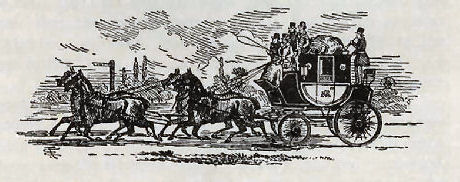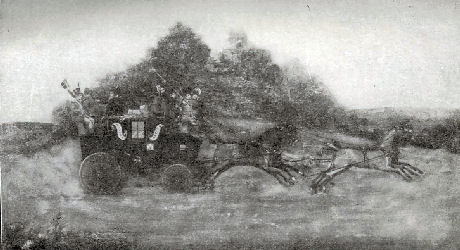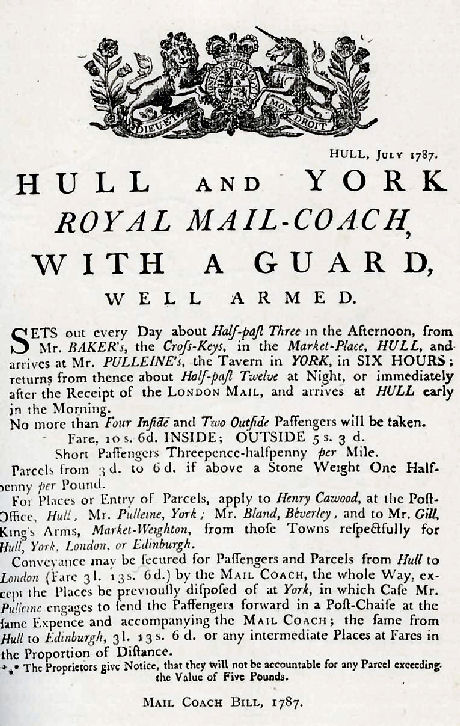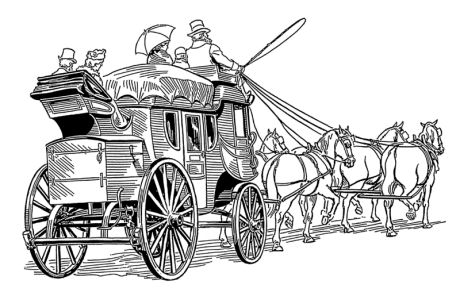 The Roman road from Brough to Easingwold and the North lies to the south west of Pocklington. At Barmby Moor a branch of that road went westward to York. However the bridge over the river Derwent at Sutton on Derwent carrying the road from York is mentioned as early as 1396 whilst the bridge at Kexby, some two miles to the north, near the Roman ford, apparently dates from the late 1420s. It may be that fourteenth century travellers from York to Beverley crossed the Derwent at Sutton on Derwent, came through Barmby Moor, crossed Pocklington beck in Pocklington and then went along the roads to the north west of the Roman road, perhaps through Goodmanham and Arras rather than through Market Weighton. Richard Judson, a Pocklington joiner, was getting timber through Sutton in the early nineteenth century.
Around 1540, John Leland, travelling from York to Beverley, crossed the 'bridge of three fair arches of stone' at Kexby, went through Wilberfoss, Barmby Moor and Hayton, passing over Pocklington Beck, 'leaving Pocklington about a mile on the left hand'. He then went to Market Weighton, 'a great uplandish village', to Sancton, and then to Leconfield, before turning south to Beverley.So it is clear that by that date the main road from York crossed the Derwent at Kexby and more or less followed the line of the Roman road to Market Weighton. His diversion through Sancton and Leconfield may have been just that, though the pre-turnpike road for Beverley out of Market Weighton did avoid the present line up Arras hill.
 |
The Hull and Beverley Stage Coach - "Wilson's Safety" |
Once the road from York to Beverley began to carry regular traffic, Market Weighton must have become a natural stopping place. It is nineteen miles from York and at the foot of the Wolds. To the east there is a steep climb onto the Wolds before the road runs gently down to Beverley, some nine miles away. Thoresby apparently took refreshment at Market Weighton in 1678 when the coach from York stopped there on the way to Hull. So its location would mean that it would benefit from increased traffic. By contrast, in 1755 Pocklington was still focussed on routes that ignored the Roman road, though it may well have been that travellers did still cross Pocklington Beck in the town during the winter, rejoining the main road at Market Weighton.
The Pocklington Enclosure Award, made under the Act of 1757, throws some light on the outlook within the town about the importance of the York to Beverley road. The initiative for this relatively early parliamentary enclosure would have come from the leading landowners, notably the Dolmans, who were then in some financial difficulty. However the award to a local brewer, Timothy Overend, of a compact block of forty acres at the junction of a new road from the south east of Pocklington with the high road from York to Beverley, suggests that he at least was well aware of the advantages that could accrue from the enclosure. It was the site of the New Inn (now the Yorkway Motel) and Pocklington's racecourse. And a new road to the east of the town, and improvements to existing roads, provided a better route to Kilwick, probably the main route into the town from the Wolds – and also to Kilwick Percy Hall, the principal residence of Sir Edmund Anderson, an influential East Riding Justice of the Peace.
The draining of the common to the south of the town allowed a new road to be laid out across the common, described in the Enclosure Award as the highway from York to Weighton, and gave Pocklington new roads to the east and south east. The Jeffreys map of 1775 suggests a town at the hub of local communications, whereas in 1748 Defoe, going from York to Beverley, said that he was told Pocklington was ‘so inconsiderable that it would not be worth our while to go so much out of our way to see it’.

The initial pressure to turnpike the road from Beverley to York came from Beverley Corporation. A 'high post' along the Beverley to York road had begun in 1734 and the road from Hull to Beverley had been turnpiked since 1744. It has also been suggested that that the Beverley to York road was deteriorating in substantial sections, particularly in the Pocklington area after the Pocklington Enclosure Award of 1757, but it is quite likely that part of the problem was in fact increased traffic along the road.
On the face of it the turnpiking of the York to Beverley road by the Acts of 1764 and 1765 was principally the work of Beverley Corporation, York Corporation's part being essentially obstructive and resulting in there being two Trusts, one for the road from Beverley to Kexby Bridge and a second for the section from Kexby Bridge to York. Neither the House of Commons Journal nor the surviving papers deposited in the East Yorkshire Archives give any indication of any positive involvement on the part of Pocklington. The trust for the Beverley to Kexby Bridge turnpike was run from Beverley - the return under the Act of 1 Geo IV c95 was by H.J. Shepherd, a Beverley lawyer and Mayor of the town in 1825/6. Nevertheless, amongst the usual massive list of the trustees in the 1764 Act, which includes the Corporations of both Beverley and York, were some leading Pocklington townspeople.A further indication of the interest of Pocklington in the turnpike is the list of those who initially invested in the York to Kexby turnpike, although one must accept that by this time some lenders had no direct interest in improved roads and lent money simply for the return. Francis Barlow of Pocklington subscribed £500 out of the initial £3,000, as much as was subscribed by the Mayor & Commonalty of the City of York; and this in the York - Kexby Bridge turnpike, not the Beverley - Kexby Bridge turnpike, for which unfortunately, no similar record appears to have survived.
 |
|
 |
| The Pocklington Diligence Stagecoach ran from Hull, through Beverley and Pocklington and on to the Black Swan Inn in Coney Street in York |
Writing in 1971, Dr. David Neave suggested 'the new turnpiked road had a detrimental effect on Pocklington as, by passing the town and by the provision of coaching inns (the New Inn and the Barmby Moor Inn) on the road itself, it took trade away from the town' but Dr. Neave's views may now be different to those he put forward in 1971. Such indications as are now available suggest that the leading townsmen of Pocklington were well aware of the need to make full use of the turnpike and did so. The townsmen of Pocklington may have had limited involvement in the turnpiking of the road between York and Beverley but they were active participants in the development of the traffic generated by that turnpike.
Roger Bellingham
10th January 2009
|

